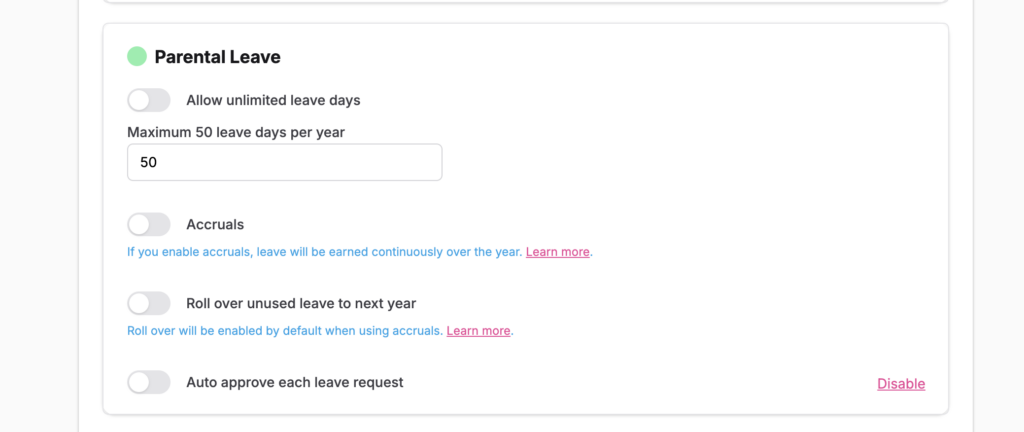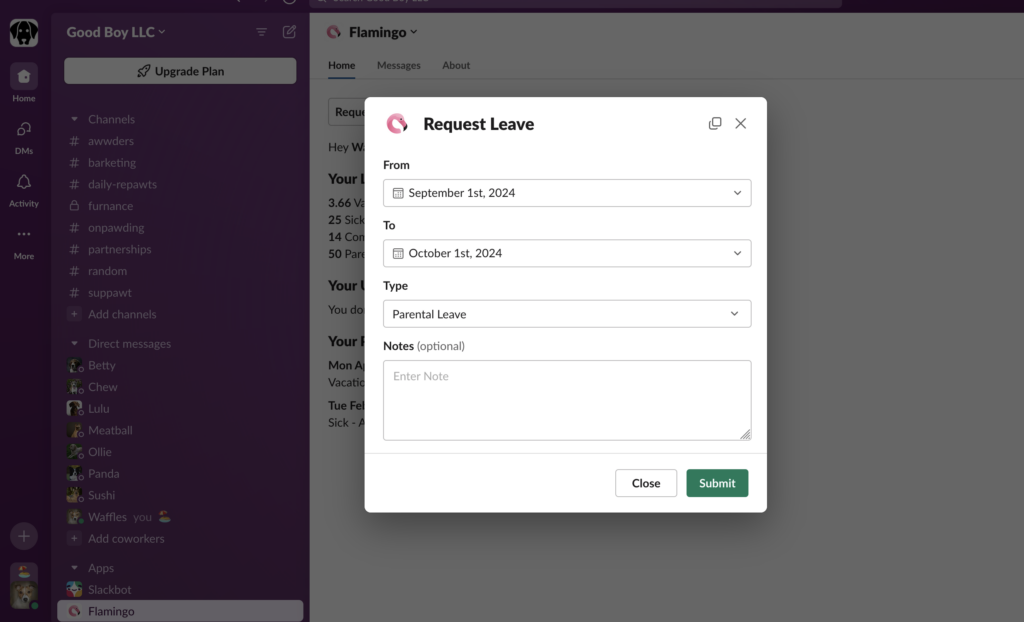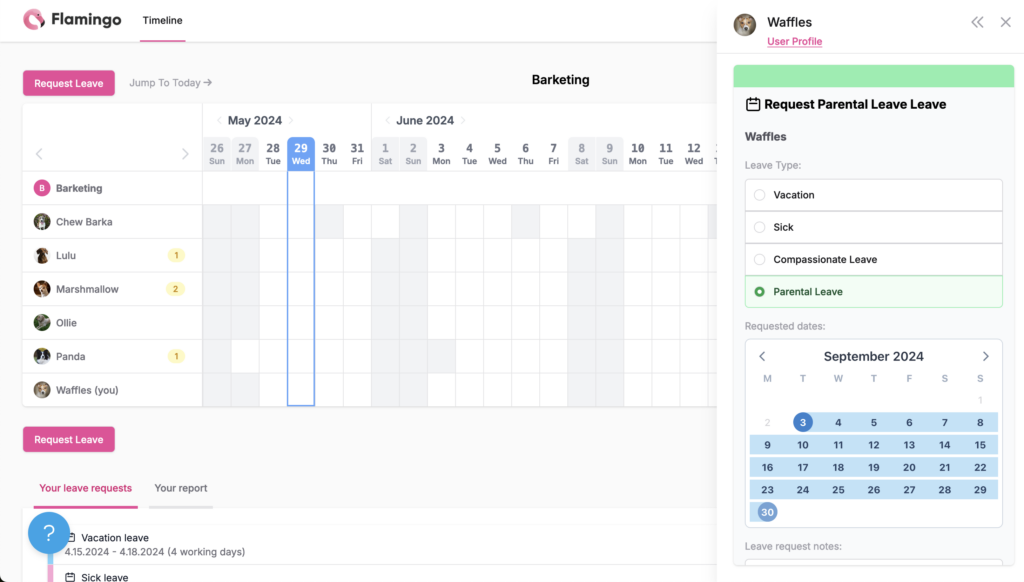September 2, 2024
Voting Leave in the USA – Which States Require Paid Voting Leave?
Election day, and the lead-up to election day, can be a stressful time in the workplace. For team leaders or ...
You’re probably familiar with maternity leave, but what about paternity leave?
What if I told you that 90 countries in the world require companies to provide paternity leave (compared to 187 for maternity leave)? Would you be surprised that it’s so high, or that it’s so low?
Paternity leave is a growing trend, and becoming more the norm, now that more countries and organizations are waking up to the important role fathers play in their child’s formative years.
Read on as we explain all you need to know about paternity leave, including some major countries with paternity leave laws, and provide answers to some of the most commonly asked paternity leave-related questions.
Note: the term “paternity leave” is being used less and less in preference of gender-neutral terms, and to incorporate non-traditional families. As such, you may see terms such as parental leave or leave for non-birthing parents, which for the purpose of this article, we’ll consider as functionally the same thing.
Paternity leave is an approved absence from work for the father of a newborn child, usually shortly after the child’s birth.
Compared to maternity leave, paternity leave is usually a shorter duration, though more progressive countries and companies are starting to offer longer periods of paternity leave, closer to the length of time mothers usually take off work after giving birth.
At this point, however, rules and customs regarding paternity leave are extremely variable, with significant differences from one country/organization to the next.
The case of maternity leave is obvious – new mothers need time to recover from the toll placed on them by childbirth. They also need time to care for and bond with their newborn child.
But how about for new fathers?
While fathers don’t need to recover physically from childbirth, they need time to bond with their child as mothers do.
This is a defining moment in the lives of both father and child. Studies show a correlation between the length of paternity leave and the father’s involvement in their child’s life.
Further benefits of increased paternal involvement in a child’s life include:
It’s also been shown that paternity leave has a beneficial effect on the father’s mental wellbeing.
In addition, a father being able to take paternity leave lets them take some of the burden of childcare off the mother, allowing them more space to recover, and to reduce stress during their postpartum period.
Alongside these benefits, it’s also important to note that a new father is likely to perform below their usual level when caring for their new child, due to sleep disruptions and other ways in which childcare takes a toll on them.
From a business’ perspective, if you’re afraid that the business will suffer for allowing new fathers to take paternity leave, research indicates otherwise.
Studies show that, of companies providing paternity leave, the majority report no adverse effects.
The right to paternity leave is not standard in every part of the world.
In some places, paternity leave is required by law. In others, it’s optional, or fathers may have the right to use part of their partner’s maternity leave. Paternity leave may also be provided as unpaid leave, with fathers having the right to take leave by not necessarily to be compensated for their time off.
So which notable countries have laws entitling new fathers to paternity leave?
Let’s look at some examples now.
Most workers in the US are eligible for unpaid paternity leave under the Family and Medical Leave Act (FMLA).
This Federal law entitles FMLA-eligible workers to up to 12 weeks of job-protected leave following the birth of a new child, or placement of an adopted/fostered child.
Federal law doesn’t provide paid paternity leave, however some states have their own laws regarding paternity leave, such as the following:
Slowly but steadily, more states are doing the same as the states above and enacting their own Paid Family Leave programs which offer similar benefits to new fathers.
Eligible fathers in the UK are entitled to 1 or 2 weeks’ paid paternity leave, paid at £184.03 or 90% of their average weekly earnings (whichever is lower).
Germany provides the right to parental leave, which covers both mothers and fathers together. Parents can take up to 3 years off work per child, and while the leave itself is unpaid, parents can claim a parental allowance during this time to cover part of their lost wages.
Fathers in France can take 25 days of paternity leave (32 days for the birth of multiple children), of which it’s mandatory to take 4 calendar days immediately after the child’s birth. Eligible workers are entitled to a percentage of their regular pay as compensation during this time.
Australia’s parental leave program provides up to 24 months of unpaid parental leave. They may be eligible for up to 20 weeks of parental leave pay during this time, paid by the government, at the national minimum wage.
New Zealand’s parental leave scheme entitles fathers to 2 weeks of unpaid leave (known as partner’s leave), along with the right to share part of the 26 weeks’ parental leave payment provided to the mother.
Singapore provides eligible fathers with 4 weeks of government-paid parental leave (GPPL), capped at $2,500 per week.
Further Reading: How much PTO is average? In the US and around the world.
Many companies go above and beyond the minimum legal requirements for paternity leave. Here are some notable examples.
Spotify is one of the most progressive companies in the world when it comes to paternity leave, offering new parents 6 months of fully paid leave.
Netflix is known for their generous work-life benefits, which includes a flexible parental leave policy. Their official policy is “take care of your baby and yourself”, and they say new parents generally take 4-8 months off.
Etsy provides new parents (regardless of gender, country of residence, family circumstance or whether they became parents through birth or adoption) to 26 weeks of fully paid parental leave.
Lululemon’s parental benefits include up to 6 months of paid parental leave for global parents at all levels, regardless of gender, including adoption, with the full amount of leave depending on tenure.
Alongside 26 weeks of parental leave for birthing parents, Atlassian provides 20 weeks of paid parental leave for non-birthing parents, putting them up with the most generous companies in terms of paternity/parental leave.
Google reportedly provides 18 weeks of parental leave for all parents, increasing to 24 weeks for parents who give birth. This increased in 2022, up from 12 weeks for non-birthing parents and from 18 weeks for birthing parents.
Amazon gives eligible employees 6 weeks of fully paid leave as supporting parents or adoptive parents.
Paternity leave can be paid or unpaid. It depends on the location. Some laws give workers the right to paid (or at least partially paid) paternity leave. While other laws (such as the FMLA) allow new fathers/non-birthing parents to take leave without losing their job or their current position, but not the right to pay during this period.
Paternity leave may be paid for either by the company or the government. In some locations, companies must pay for paternity leave themselves. It’s more common, however, that paternity leave compensation comes from the government, often via social insurance that the worker must have met minimum contributions to prior to their leave.
The length of paternity leave or non-birthing parental leave varies greatly from place to place and company to company. The standard for paid paternity leave is between 1-2 weeks, but worldwide standards are gradually increasing to bring the average length of paternity leave closer to the length of leave entitled to birthing parents.
Paternity leave is primarily to allow non-birthing parents to bond with their new child. It also lets them take some of the burden of childcare off the mother, and frees the parent from the stress of having to work while handling extra responsibilities and sleep disruptions at home.
Paternity leave or parental leave is typically given to any non-birthing parent, including parents who adopt or foster a child. Sometimes paternity leave or parental leave is extended to other relatives, such as grandparents, if they are forced to be a primary caregiver for the child.
Paternity leave, or parental leave for non-birthing parents, should be considered a right more than a “nice to have” employee benefit.
The period after a child’s birth is a vital one, not only for the child but for the parents as well. You can show you value your employees as human beings by accepting this and providing them with ample time off (ideally with pay) to develop a bond with their new child.
If you’re a Flamingo user, add paternity leave or parental leave to your leave policy to let your team members know what they can expect after the birth of their child.
Go into the Settings tab, click on Leave Types, and add a new leave type.

Next, go into your team settings, click on Leave Policy, and set up how many days of parental/paternity leave your team members can take.

Now it will be easy and stress-free for employees to book in their parental leave, either through Slack, MS Teams or the Flamingo web app.


Flamingo will keep track of their leave dates and make it easy to know when they’ll be back, and when you should give them space to focus on the new addition to their family.
Try Flamingo for free to manage your team’s paternity leave and non-birthing parental leave more efficiently, starting now.
Flamingo makes managing your team’s paid time off a breeze.